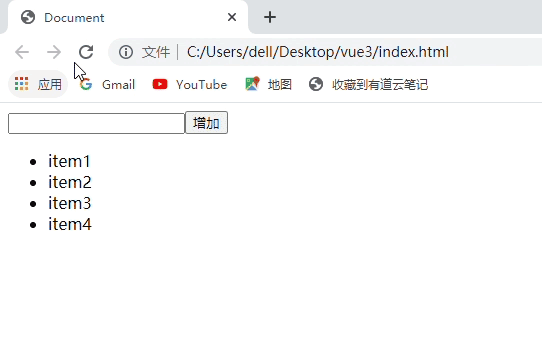Vue3实现列表循环
今天小编和大家一起在Vue的路上探索,要实现的功能是这样的。现将默认 数组内的渲染到页面上,然后点击按钮之后,将文本框内的数据添加到列表上,效果如下

源码是这样的,下面我就结合代码中的注释来说明一下核心的代码
Vue.createApp({ data(){ return { list:['item1','item2','item3','item4'], // 绑定v-for循环的列表 inputVal:"" // 绑定文本框的内容 } }, methods:{ handleAddItem(){ // 绑定按钮的点击事件 this.list.push(this.inputVal) // 修改绑定的数据,在数组中增加数据 this.inputVal = '' // 对绑定的值重新赋值,清空文本框内的值 } }, template:` <div> // 通过v-model绑定表单元素的值,也就是常说的数据双向绑定 <input v-model="inputVal" /> // v-on:click是绑定按钮的点击事件,可以通过@click语法糖来替代 <button v-on:click="handleAddItem">增加</button> <ul> // v-for和上一篇文章的v-if类似,都叫做指令 // v-for用作数据的循环 // v-for可以接受两个参数,第一个是数组中元素,第二个元素是下标 // 可以通过in和of两个关键字链接绑定的变量 // 不建议将v-if和v-for用在同一个元素上。非要用可以在外面嵌套div或者其他元素 // 根据官方文档,同时使用的时候,v-for的优先级会高于v-if <li v-for="(item,index) of list">{{item}}</li> </ul> </div> ` }).mount('#root')
之前有过基础或者细心的小伙伴会发现,小编在使用v-for的时候,后面用的是of关键字,那对于v-for来说,虽然官方文档给的是in,那么of和in有什么不一样呢?在原生js中,对于循环来说,可以使用关键字in和for来循环,得到的结果是不一样的,就像这样
let arr = [ {name:'lilei',age:12}, {name:'hanmeimei',age:20} ] for(let item of arr){ console.log(item) // {{name:'lilei',age:12} {name:'hanmeimei',age:20} } for(let key in arr){ console.log(item) // 0 1 }
小编在查询了一些资料后,得到这样的结论,遍历数组的时候,推荐使用of,语法为(item,index)。在遍历对象的时候,推荐使用in,语法为(item,name,index)下面是实例
DATA: list:[ {name:'1'}, {name:'2'}, {name:'3'}, ] html: <div class="items" v-for='(item,name,index) of list'>{{item}}->{{name}}->{{index}}</div> <div class="items" v-for='(item,name,index) in list'>{{item}}->{{name}}->{{index}}</div> // 输出结果如下 { "name": "1" }->0-> { "name": "2" }->1-> { "name": "3" }->2-> { "name": "1" }->0-> { "name": "2" }->1-> { "name": "3" }->2->
DATA: listObject:{ name:'soho', age:25, class:1909, grade:3 } html: <div class="items" v-for='(item,name,index) of listObject'>{{item}}->{{name}}->{{index}}</div> <div class="items" v-for='(item,name,index) in listObject'>{{item}}->{{name}}->{{index}}</div> // 输出结果为 soho->name->0 25->age->1 1909->class->2 3->grade->3 soho->name->0 25->age->1 1909->class->2 3->grade->3
参考文章:
https://vue3js.cn/
https://www.cnblogs.com/Scooby/p/12160313.html


 浙公网安备 33010602011771号
浙公网安备 33010602011771号